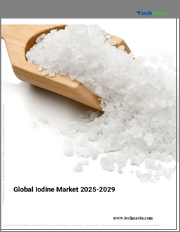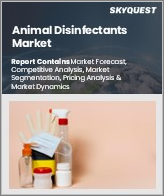
|
시장보고서
상품코드
1525326
세계의 요오드 결핍 치료제 시장 규모 조사 : 제형별, 유통 채널별 및 지역별 예측(2022-2032년)Global Iodine Deficiency Drug Market Size study, by Dosage Form (Tablets, Others), by Distribution Channel (Hospital Pharmacies, Drug Stores and Retail Pharmacies, Online Providers), and Regional Forecasts 2022-2032 |
||||||
세계 요오드 결핍 치료제 시장은 2023년 약 41억 4,000만 달러로 평가되었고, 2024-2032년의 예측 기간 동안 5.76% 이상의 견실한 성장률로 성장할 것으로 예상됩니다.
요오드 결핍증(IDD)은 식이 요오드 섭취 부족으로 인해 갑상선 호르몬이 제대로 생성되지 않아 발생하는 질환으로 전 세계적으로 심각한 공중보건 문제로 대두되고 있습니다. 갑상선 기능 저하증으로 알려진 이 결핍증은 모든 연령, 성별, 인종에서 발생할 수 있지만, 특히 60세 이상의 여성과 어린이를 중심으로 여러 나라에서 널리 퍼져 있습니다. 제약사들은 레보티록신 의약품 개발 및 승인에 적극적으로 나서고 있으며, 특히 의료 인프라가 미비한 지역 수요 증가에 대응하기 위해 노력하고 있습니다. 예를 들어, 2021년 Zydus Cadila는 갑상선 기능 저하증 치료제가 미국 FDA 승인을 받았다고 발표했습니다.
갑상선 기능 저하증의 전 세계 유병률 증가는 시장에서 요오드 결핍 치료제에 대한 수요를 촉진하는 주요 요인입니다. 갑상선 호르몬 생산 부족을 특징으로 하는 갑상선 기능 저하증은 특히 요오드 첨가 소금을 충분히 섭취하지 못하는 지역에서 요오드 결핍으로 인해 발생하는 경우가 많습니다. 갑상선 기능에서 요오드의 중요성에 대한 인식이 높아짐에 따라 의료진은 갑상선 기능 저하증을 더 많이 진단하고 있으며, 요오드 보충 요법의 필요성이 증가하고 있습니다. 정부 및 보건 기관도 요오드 결핍을 해결하기 위한 프로그램을 시행하고 있어 시장 성장을 더욱 촉진하고 있습니다. 제약회사들은 다양한 환자군과 지역의 요구에 맞추어 요오드 보충제의 혁신적인 제형과 제형을 개발하여 시장 성장에 기여하고 있습니다. 이러한 추진력은 갑상선 질환 관리에서 요오드 결핍 치료제의 중요한 역할을 강조하고 세계 공중보건 전략에서 요오드 결핍 치료제의 중요성이 증가하고 있음을 강조합니다. 그러나 불규칙한 심계항진 등 레보티록신과 관련된 부작용과 임신 중 또는 심장병 환자의 정기적인 혈액 검사의 필요성이 시장 성장을 저해하고 있습니다.
세계 요오드 결핍 치료제 시장의 주요 지역으로는 북미, 유럽, 아시아태평양, 라틴아메리카, 중동 및 아프리카가 있으며, 2023년에는 유럽이 2024-2032년의 예측 기간 동안 가장 빠르게 성장할 것으로 예상되며, 2023년에는 유럽이 세계 요오드 결핍 치료제 시장을 장악할 것으로 예상됩니다. 이는 엄격한 공중보건 조치, 요오드 첨가 소금 프로그램의 보급, 갑상선 질환에 대한 높은 인식이 높기 때문입니다. 이 지역 국가들은 갑상선 기능 저하증이나 갑상선종과 같은 갑상선 관련 건강 문제의 원인이 되는 요오드 결핍을 예방하기 위해 요오드 보충을 우선순위로 삼고 있습니다. 유럽 제약사들은 다양한 사람들의 요구에 맞는 효과적인 요오드 보충제 개발에 주력하고 있습니다. 이 지역의 의료 인프라와 적극적인 연구 접근 방식은 지속적인 기술 혁신을 촉진하고 높은 수준의 요오드 결핍 관리를 보장합니다. 이러한 리더십을 바탕으로 유럽은 요오드 결핍 치료제 세계 시장 형성에서 매우 중요한 역할을 담당하고 있습니다.
목차
제1장 세계의 요오드 결핍증 치료제 시장 : 주요 요약
- 세계의 요오드 결핍증 치료제 시장 규모와 예측(2022-2032년)
- 지역별 개요
- 부문별 개요
- 제형별
- 유통 채널별
- 주요 동향
- 경기후퇴의 영향
- 애널리스트의 결론 및 제안
제2장 세계의 요오드 결핍증 치료제 시장 정의와 조사의 전제조건
- 조사 목적
- 시장의 정의
- 조사의 전제조건
- 포함과 제외
- 제한 사항
- 공급측 분석
- 가용성
- 인프라
- 규제 환경
- 시장 경쟁
- 경제성(소비자 시점)
- 수요측 분석
- 규제 프레임워크
- 기술 진보
- 친환경
- 소비자 의식과 수용
- 조사 방법
- 조사 대상년도
- 통화 환산율
제3장 세계의 요오드 결핍증 치료제 시장 역학
- 시장 성장 촉진요인
- 시장이 해결해야 할 과제
- 시장 기회
제4장 세계의 요오드 결핍증 치료제 시장 : 산업 분석
- Porter's Five Forces 모델
- 공급 기업의 교섭력
- 바이어의 교섭력
- 신규 진출업체의 위협
- 대체품의 위협
- 경쟁 기업간 경쟁 관계
- Porter's Five Forces 모델에 대한 미래적 접근
- Porter's Five Forces의 영향 분석
- PESTEL 분석
- 정치
- 경제
- 사회
- 기술
- 환경
- 법률
- 주요 투자 기회
- 주요 성공 전략
- 파괴적 동향
- 업계 전문가의 견해
- 애널리스트의 결론 및 제안
제5장 세계의 요오드 결핍증 치료제 시장 규모와 예측 : 제형별, 2022년-2032년
- 부문 대시보드
- 세계의 요오드 결핍증 치료제 시장 : 제형별 매출 동향 분석, 2022년·2032년
- 정제
- 기타
제6장 세계의 요오드 결핍증 치료제 시장 규모와 예측 : 유통 채널별, 2022년-2032년
- 부문 대시보드
- 세계의 요오드 결핍증 치료제 시장 : 유통 채널별 매출 동향 분석, 2022년·2032년
- 병원 약국
- 드럭스토어 및 소매 약국
- 온라인 공급업체
제7장 세계의 요오드 결핍증 치료제 시장 규모와 예측 : 지역별, 2022년-2032년
- 북미
- 미국
- 캐나다
- 유럽
- 영국
- 독일
- 프랑스
- 스페인
- 이탈리아
- 기타 유럽
- 아시아태평양
- 중국
- 인도
- 일본
- 호주
- 한국
- 기타 아시아태평양
- 라틴아메리카
- 브라질
- 멕시코
- 기타 라틴아메리카
- 중동 및 아프리카
- 사우디아라비아
- 남아프리카공화국
- 기타 중동 및 아프리카
제8장 경쟁 정보
- 주요 기업의 SWOT 분석
- 주요 시장 전략
- 기업 개요
- Abbott Laboratories
- 주요 정보
- 개요
- 재무(데이터 입수가 가능한 경우)
- 제품 개요
- 시장 전략
- AbbVie Inc.
- Cipla Ltd.
- Fresenius SE & Co. KGaA(Fresenius Kabi)
- GlaxoSmithKline
- Lupin
- Macleods Pharmaceuticals
- Merck KGaA
- Pfizer
- Teva Pharmaceutical Industries Ltd., Inc.
- Abbott Laboratories
제9장 조사 과정
LSH 24.08.23The Global Iodine Deficiency Drug Market is valued approximately at USD 4.14 billion in 2023 and is anticipated to grow with a healthy growth rate of more than 5.76% over the forecast period 2024-2032. Iodine Deficiency Disorders (IDD) represent a significant public health issue globally, resulting from inadequate dietary intake of iodine, which leads to insufficient thyroid hormone production. This deficiency, known as hypothyroidism, can affect individuals of all ages, genders, and ethnicities, though it is particularly prevalent among women over the age of 60 and children in various countries. Pharmaceutical companies are actively focusing on the development and approval of levothyroxine drugs to meet the increasing demand, particularly in regions with underdeveloped healthcare infrastructure. For instance, in 2021, Zydus Cadila announced that it has received U.S. FDA approval for its thyroid drug for hypothyroidism.
The increasing prevalence of hypothyroidism globally is a key driver propelling the demand for iodine deficiency drugs in the market. Hypothyroidism, characterized by insufficient thyroid hormone production, often results from iodine deficiency, especially in regions where iodized salt intake is inadequate. As awareness grows about the importance of iodine in thyroid function, healthcare providers are diagnosing more cases of hypothyroidism, thereby boosting the need for iodine supplementation therapies. Governments and health organizations are also implementing programs to address iodine deficiency, further stimulating market growth. Pharmaceutical companies are responding with innovative formulations and dosage forms of iodine supplements tailored to different patient demographics and regional needs. This driver underscores the critical role of iodine deficiency drugs in managing thyroid disorders and highlights their increasing importance in public health strategies worldwide. However, side effects associated with levothyroxine, such as irregular heart palpitations, and the need for regular blood tests during pregnancy and in heart patients restrain market growth.
The key region in the Global Iodine Deficiency Drugs Market includes North America, Europe, Asia Pacific, Latin America, and Middle East & Africa. In 2023, the Europe dominates the Global Iodine Deficiency Drugs Market in terms of revenue and expected to grow fastest during the forecast period 2024-2032. This is due to stringent public health measures, widespread iodized salt programs, and high awareness of thyroid disorders. Countries across the region prioritize iodine supplementation to prevent deficiencies, which contribute to thyroid-related health issues like hypothyroidism and goiter. Pharmaceutical companies in Europe focus on developing effective iodine supplements tailored to diverse population needs. The region's proactive approach in healthcare infrastructure and research fosters continuous innovation and ensures high standards of iodine deficiency management. This leadership solidifies Europe's pivotal role in shaping the global market for iodine deficiency drugs.
Major companies operating in the Global Iodine Deficiency Drug Market include
Abbott Laboratories
AbbVie Inc.
Cipla Ltd.
Fresenius SE & Co. KGaA (Fresenius Kabi)
GlaxoSmithKline
Lupin
Macleods Pharmaceuticals
Merck KGaA
Pfizer
Teva Pharmaceutical Industries Ltd., Inc.
By Region:
- North America
- U.S.
- Canada
- Europe
- UK
- Germany
- France
- Spain
- Italy
- ROE
- Asia Pacific
- China
- India
- Japan
- Australia
- South Korea
- RoAPAC
- Latin America
- Brazil
- Mexico
- Rest of Latin America
- Middle East & Africa
- Saudi Arabia
- South Africa
- RoMEA
Years considered for the study are as follows:
- Historical year - 2022
- Base year - 2023
- Forecast period - 2024 to 2032
Key Takeaways:
- Market Estimates & Forecast for 10 years from 2022 to 2032.
- Annualized revenues and regional level analysis for each market segment.
- Detailed analysis of geographical landscape with Country level analysis of major regions.
- Competitive landscape with information on major players in the market.
- Analysis of key business strategies and recommendations on future market approach.
- Analysis of competitive structure of the market.
- Demand side and supply side analysis of the market.
Table of Contents
Chapter 1. Global Iodine Deficiency Drug Market Executive Summary
- 1.1. Global Iodine Deficiency Drug Market Size & Forecast (2022-2032)
- 1.2. Regional Summary
- 1.3. Segmental Summary
- 1.3.1. By Dosage Form
- 1.3.2. By Distribution Channel
- 1.4. Key Trends
- 1.5. Recession Impact
- 1.6. Analyst Recommendation & Conclusion
Chapter 2. Global Iodine Deficiency Drug Market Definition and Research Assumptions
- 2.1. Research Objective
- 2.2. Market Definition
- 2.3. Research Assumptions
- 2.3.1. Inclusion & Exclusion
- 2.3.2. Limitations
- 2.3.3. Supply Side Analysis
- 2.3.3.1. Availability
- 2.3.3.2. Infrastructure
- 2.3.3.3. Regulatory Environment
- 2.3.3.4. Market Competition
- 2.3.3.5. Economic Viability (Consumer's Perspective)
- 2.3.4. Demand Side Analysis
- 2.3.4.1. Regulatory frameworks
- 2.3.4.2. Technological Advancements
- 2.3.4.3. Environmental Considerations
- 2.3.4.4. Consumer Awareness & Acceptance
- 2.4. Estimation Methodology
- 2.5. Years Considered for the Study
- 2.6. Currency Conversion Rates
Chapter 3. Global Iodine Deficiency Drug Market Dynamics
- 3.1. Market Drivers
- 3.1.1. Increase in Prevalence of Hypothyroidism
- 3.1.2. Education and Awareness Programs
- 3.1.3. Increase in Hypothyroidism in Children
- 3.2. Market Challenges
- 3.2.1. Side Effects of Levothyroxine
- 3.2.2. Need for Regular Blood Tests
- 3.3. Market Opportunities
- 3.3.1. Pharmaceutical Interest in Developing Regions
- 3.3.2. R&D Investments
Chapter 4. Global Iodine Deficiency Drug Market Industry Analysis
- 4.1. Porter's 5 Force Model
- 4.1.1. Bargaining Power of Suppliers
- 4.1.2. Bargaining Power of Buyers
- 4.1.3. Threat of New Entrants
- 4.1.4. Threat of Substitutes
- 4.1.5. Competitive Rivalry
- 4.1.6. Futuristic Approach to Porter's 5 Force Model
- 4.1.7. Porter's 5 Force Impact Analysis
- 4.2. PESTEL Analysis
- 4.2.1. Political
- 4.2.2. Economical
- 4.2.3. Social
- 4.2.4. Technological
- 4.2.5. Environmental
- 4.2.6. Legal
- 4.3. Top Investment Opportunity
- 4.4. Top Winning Strategies
- 4.5. Disruptive Trends
- 4.6. Industry Expert Perspective
- 4.7. Analyst Recommendation & Conclusion
Chapter 5. Global Iodine Deficiency Drug Market Size & Forecasts by Dosage Form 2022-2032
- 5.1. Segment Dashboard
- 5.2. Global Iodine Deficiency Drug Market: Dosage Form Revenue Trend Analysis, 2022 & 2032 (USD Billion)
- 5.2.1. Tablets
- 5.2.2. Others
Chapter 6. Global Iodine Deficiency Drug Market Size & Forecasts by Distribution Channel 2022-2032
- 6.1. Segment Dashboard
- 6.2. Global Iodine Deficiency Drug Market: Distribution Channel Revenue Trend Analysis, 2022 & 2032 (USD Billion)
- 6.2.1. Hospital Pharmacies
- 6.2.2. Drug Stores and Retail Pharmacies
- 6.2.3. Online Providers
Chapter 7. Global Iodine Deficiency Drug Market Size & Forecasts by Region 2022-2032
- 7.1. North America Iodine Deficiency Drug Market
- 7.1.1. U.S. Iodine Deficiency Drug Market
- 7.1.1.1. Dosage Form breakdown size & forecasts, 2022-2032
- 7.1.1.2. Distribution Channel breakdown size & forecasts, 2022-2032
- 7.1.2. Canada Iodine Deficiency Drug Market
- 7.1.1. U.S. Iodine Deficiency Drug Market
- 7.2. Europe Iodine Deficiency Drug Market
- 7.2.1. U.K. Iodine Deficiency Drug Market
- 7.2.2. Germany Iodine Deficiency Drug Market
- 7.2.3. France Iodine Deficiency Drug Market
- 7.2.4. Spain Iodine Deficiency Drug Market
- 7.2.5. Italy Iodine Deficiency Drug Market
- 7.2.6. Rest of Europe Iodine Deficiency Drug Market
- 7.3. Asia-Pacific Iodine Deficiency Drug Market
- 7.3.1. China Iodine Deficiency Drug Market
- 7.3.2. India Iodine Deficiency Drug Market
- 7.3.3. Japan Iodine Deficiency Drug Market
- 7.3.4. Australia Iodine Deficiency Drug Market
- 7.3.5. South Korea Iodine Deficiency Drug Market
- 7.3.6. Rest of Asia Pacific Iodine Deficiency Drug Market
- 7.4. Latin America Iodine Deficiency Drug Market
- 7.4.1. Brazil Iodine Deficiency Drug Market
- 7.4.2. Mexico Iodine Deficiency Drug Market
- 7.4.3. Rest of Latin America Iodine Deficiency Drug Market
- 7.5. Middle East & Africa Iodine Deficiency Drug Market
- 7.5.1. Saudi Arabia Iodine Deficiency Drug Market
- 7.5.2. South Africa Iodine Deficiency Drug Market
- 7.5.3. Rest of Middle East & Africa Iodine Deficiency Drug Market
Chapter 8. Competitive Intelligence
- 8.1. Key Company SWOT Analysis
- 8.2. Top Market Strategies
- 8.3. Company Profiles
- 8.3.1. Abbott Laboratories
- 8.3.1.1. Key Information
- 8.3.1.2. Overview
- 8.3.1.3. Financial (Subject to Data Availability)
- 8.3.1.4. Product Summary
- 8.3.1.5. Market Strategies
- 8.3.2. AbbVie Inc.
- 8.3.3. Cipla Ltd.
- 8.3.4. Fresenius SE & Co. KGaA (Fresenius Kabi)
- 8.3.5. GlaxoSmithKline
- 8.3.6. Lupin
- 8.3.7. Macleods Pharmaceuticals
- 8.3.8. Merck KGaA
- 8.3.9. Pfizer
- 8.3.10. Teva Pharmaceutical Industries Ltd., Inc.
- 8.3.1. Abbott Laboratories
Chapter 9. Research Process
- 9.1. Research Process
- 9.1.1. Data Mining
- 9.1.2. Analysis
- 9.1.3. Market Estimation
- 9.1.4. Validation
- 9.1.5. Publishing
- 9.2. Research Attributes



















